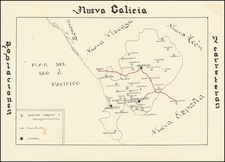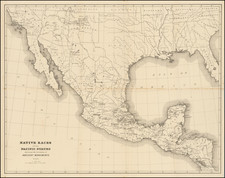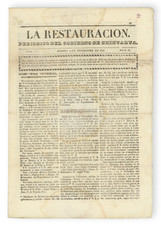Survey of Santa María Huexoculco by Renowned Surveyor Antonio Cataño Cordero
This maps shows a survey of the town of Santa María Huexoculco in the modern state of Mexico by the noted surveyor Antonio Cataño Cordero. It chronicles a survey undertaken to clarify a boundary requested by a wealthy local landowner, Don Bernardo Velasquez.
The town is to the left of the center on the document, toward the north on this east-oriented survey. To the east, at the top of the page, are lofty mountains, the Sierra Madre de Tlamanalco. Toward the south, as indicated by the dotted line at the bottom of the page, is the camino real to Tlamanalco, where the survey was written according to Cataño Cordero.
Cataño Cordero was a prolific royal surveyor active in central Mexico from 1720s to the 1780s. The Archivo General de la Nación has at least sixteen of his surveys, but not this example. His work on this survey, which seems to have been done at the request of Don Bernardo Velasquez, reveals the main reason for surveys in colonial New Spain: land disputes.
Another of Cataño Cordero's projects explain why surveys were conducted mainly for use in law suits. On May 28, 1731, Cataño Cordero requested 50 pesos from the cabildo of Mexico City to complete the measurement of the tierras de Cerrillo. The City Council said no, although it did grant 25 pesos to another surveyor for the same job. Surveys were expensive in the eighteenth century and government and landowners were loath to pay for them unless it was absolutely, meaning legally, necessary.
While in the eighteenth century it was a quiet town, today Santa María Huexoculco is best known for its social and economic deprivation and street markets allegedly selling stolen goods. Tlalmanalco, by contrast, has been labeled a " pueblo con encanto", or a town with charm.
There has been a settlement at Tlalmanalco since 3100 BCE. The area was one of the last to be conquered by the Aztecs, surrendering after a century of fighting in 1465. The Spanish town was founded in 1525, when the indigenous shrine was destroyed; the church was dedicated in 1532. Indigenous peoples were subjected to indentured servitude from 1550 to 1633. They worked mainly in agriculture, the main economic function of the area until the mid-nineteenth century, when textile factories, a paper mill, and a copper smelter were built.
Both towns are near the volcanos of what is today the Izta-Popo Zoquiapan National Park. These are the peaks that loom over the survey.
A transcript of the explanation on the survey:
"Ba este mapa fiel, y legalmente delineado á todo mí leal saber, y entender, sin dolo, fraude, ní encubierta de malícia, contra alguna de las partes, y sus términos, confines, y linderos, en sus lexitimos lugares, y cituasiones colocados, según, y como en el campo los oí, y reconocí, así lo Juro por Dios Nuestro Señor, y la señal de la Santa Cruz, y lo firmo en este pueblo de Tlalmanalco en diez y nueve de Junio de mill, setesientos, y sinquenta años.
Ant. Cataño Cordero."
Amanda de la Riva Fernández, Guía de las Actas de Cabildo de la Ciudad de Mexico (Departamento del Distrito Federal and Universidad Iberoamericana: Mexico, 1988), 16.
José Ignacio Urquiola Permisán, “El Arte de Medir y Pesar las Aguas,” Ciencia@UAQ 2, no. 1 (2009): 60.










![[Chiapas] Carta Postal de la Republica Mexicana Estado de Chiapas . . . 1934](https://storage.googleapis.com/raremaps/img/small/55436.jpg)

![(Mexican-Aztec Painting) [Original Watercolor of Aztec Deities from Codex Telleriano-Remensis]](https://storage.googleapis.com/raremaps/img/small/103007.jpg)
![Culiacanae, Americae Regionis, Descriptio [with] Hispaniolae, Cubae, Aliarumqe Insualrum Circumiacientium Delineatio](https://storage.googleapis.com/raremaps/img/small/86114.jpg)
